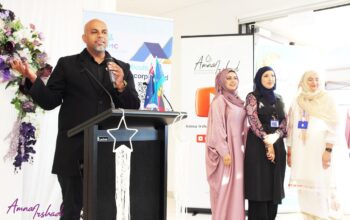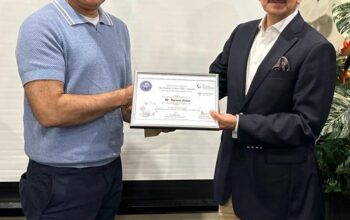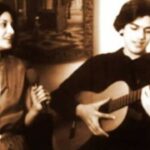A Current Affair reporter reunites with Christchurch earthquake survivor he helped save
t’s been 10 years since a devastating earthquake hit New Zealand’s South Island capital, Christchurch.
It killed 185 people.
Tonight, A Current Affair speaks to the last person to be pulled out of the rubble alive
Ann Bodkin was only discovered after ACA reporter Simon Bouda and camera operator Shaun Wellfare heard her feeble cries for help.
You can watch her reunite with Bouda in the video above.
This is an abridged version of a chapter in Simon Bouda’s autobiography, “Deadline”.
A Voice from the Rubble
As a reporter, I’ve covered many disasters — earthquakes, tsunamis, bushfires, floods. But I have never saved someone’s life.
All that changed about 11 o’clock on the morning of February 23, 2011.
It had been an amazing 24 hours since news of Christchurch’s devastating earthquake broke.
Late on February 22, with Christchurch Airport was closed, Channel Nine had chartered a plane from Sydney to Dunedin.
Onboard was a large contingent of Channel Nine journalists, camera crews and satellite technicians.
On arrival in Dunedin, Cameraman Shaun Wellfare and I rented a car and drove about five hours north to the South Island’s capital city.
During that long drive I rang Ken Murphy, who was the NSW Fire and Rescue media liaison officer in Sydney, to ask if I could join an USAR — Urban Search and Rescue — team when I arrived in Christchurch.
I wanted to be able to show the Australian public what role the Aussie rescuers were performing.
We arrived in Christchurch about 4.30am to find much of the city had been cordoned off.
Armoured military vehicles and police were manning roadblocks, preventing people from entering Christchurch’s heart.
We negotiated our way to the central command post, set up in Latimer Square. It would become home for the next three days.
The Australian USAR team had not yet arrived so Shaun and I took a walk through the pre-dawn CBD.
Row after row of buildings had crumbled into the streets. Scaffolding on some of the taller buildings (was this a remnant of the previous quake? I don’t know) had been peeled away like bark off a tree.
Parked cars had been flattened. We saw two buses that were completely crushed.
It resembled yet another war zone.
I’d been to the war-torn Middle East before and what I witnessed in Christchurch that morning was every bit as devastating. So much of the CBD was just a pile of rubble.
The streets were eerily deserted.
Occasionally we spotted an ambulance or a police car slowly cruising through the mess.
The whole city was enveloped in silence, but it was an eerie strange silence, broken only when a flock of screeching seagulls suddenly took to the air as the ground beneath my feet began to shake.
It was about 6am.
Aftershock!
We glanced all around expecting any one of the hundreds of damaged buildings to come crashing down.
Windows rattled, the telegraph poles swayed.
Then, within seconds it was over, and the silence returned.
Neither of us said a word, we both knew we should get the hell out of there.
The Aussie USAR team of about 30 firefighters and paramedics were arriving just as we got back to Latimer Square.
I explained that I wanted to join them on their mission but would obviously observe the safety demands.
“Sure, we’re heading into the city for a recon,” said the team leader, Station Commander Bruce Cameron.
“We’re leaving soon.”
Over the next few hours, we joined Bruce’s team, Alpha One, as they combed the streets, examining crumbled buildings and looking for signs of life.
“Fire Rescue above … can you hear me?” the rescuers called repeatedly into the rubble.
Ominously, not a whisper came back. Then, after a few hours Bruce received a radio message.
“We’re being re-tasked to the Pyne Gould Corporation (PGC) building,” he explained.
The earthquake had brought the four-storey building structure, in Cambridge Terrace, central Christchurch, crashing down.
Few would forget the images beamed around the world of the building, which had concertinaed.
As we arrived at the PGC Building, members of the New Zealand Urban Search and Rescue team were just about to pull a survivor from the rubble
It’s amazing how uplifting it is when you’re in the midst of such devastation to witness a rescue.
With his family there to watch, and will the rescuers on, James Faithful was lifted off the site by a crane and whisked ooff to hospital.
“We’re elated that we have got him back … we always knew he’d be right but it’s just great that we have got him back,” his sister-in-law, Michelle Wilson told me.
“He’s a bit dazed and bit stunned.”
But the moment of joy was short-lived as we looked back at the PGC Building.
The chance of more survivors being pulled from the rubble looked pretty remote, about 20 people had already been pulled out alive and there were no apparent signs of life.
We watched as the NZ Urban Search and Rescue team left the site and prepared to hand it over to their New South Wales counterparts, who would continue to look for survivors.
Because we had accompanied the USAR team, Shaun and I were permitted to be quite close to the action.
We were on the roadway, literally about 10 metres from the collapsed PGC building.
Shaun had set up his camera on a tripod to begin filming the continuing search-and-rescue operation.
As the handover took place, a noisy fire rescue truck with a telescopic ladder, which the local rescuers had been using, was turned off.
An eerie silence descended on the site.
It was then, in that silence, that I heard a faint voice. It seemed to be coming from under the rubble just near where we were standing. It was clearly a woman’s voice.
I turned to Shaun, “Did you hear that? Did you hear a voice?”
We had both been awake for about 36 hours.
We were exhausted and I thought that maybe my mind was playing tricks on me.
As Shaun glanced back towards the building, he heard what he thought was tapping.
“There’s somebody in there … we just heard them,” we both called out to the USAR team.
All the rescuers were standing on a grass area across the road from the rubble, behind the fire truck.
There were no rescuers on the building itself and so Shaun and I were the only people close to the rubble at that stage.
Immediately, the USAR teams reacted and rushed back towards the site.
Initially a Kiwi firefighter shouted out into the rubble.
“What’s your name?” he called out. All strained to hear from under the rubble.
“Angela? Ann?”
Again, I heard the voice, this time replying to the question.
She told the rescuer her name was Ann.
Understandably there was an excited buzz among the rescuers, “Quiet on the site!” the firefighter shouted.
“Is there anybody else with you?” the firefighter called out. No, she was alone.
With contact established the NSW USAR team took over, clambering up the telescopic ladder to a point about three metres above street level.
‘We’re working as hard as we can to get you out as quickly as we can,’ Paul Sharratt shouted out.
“We’ll have someone here all the time, alright?”
The four-storey building had pancaked down on top of her.
Ann was trapped beneath her desk, which had stopped her from being crushed.
Over the next three hours, we watched and filmed the NSW USAR team as they tunnelled in to where Ann Bodkin was entombed, cutting through broken concrete and reinforcing bars, and constantly reassuring Ann that she was going to be okay.
Just as Ann was on a rescue stretcher being slowly manoeuvred to the mouth of the tunnel, another aftershock hit.
Parts of the crumbled building began to shift and collectively we held our breath.
Within seconds it had passed, and Ann’s stretcher was finally placed onto the rescue ladder and ever so slowly brought back to the ground.
Everyone on site burst into a round of applause.
Ann’s husband Graham Richardson had nervously watched every second of the rescue after receiving a telephone call from NSW firefighter Hugh Jones, who broke the news to him that his wife had been found.
“My legs are shaking,” he told me.
“My heart’s going as though I’ve done a 10K run. I couldn’t be happier.”
The next morning, I arrived at the hospital and met up with Graham.
Incredibly Ann was well enough to go home.
About 10 minutes later a beaming Graham walked out of the hospital with his wife on his arm.
She barely had a scratch on her.
I couldn’t help myself and just felt the need to give her a hug … so, I did.
“I don’t know what would have happened if you hadn’t heard my voice,” she said.
We both had tears in our eyes.
That moment is something that will stay with me forever.
So many people had died in this disaster and here was a living miracle standing before me.
It’s hard to describe the emotions.
Joy, that someone had survived, deep sorrow for all those lost.
Ann went on to tell me of her frustration at not being heard by the rescuers when she’d cried out for help.
As well as yelling, she’d used a piece of plastic to continually tap on metal.
It wasn’t until the fire engine was turned off that someone heard her.
As it turned out Ann was the last survivor of the devastating earthquake.
No-one else would be rescued.
“There’s been a huge number of people involved in that rescue,” she said.
“Starting with you, and I really, from the bottom of my heart, want to thank them all.”
It’s a pleasure, Ann, a pleasure.








